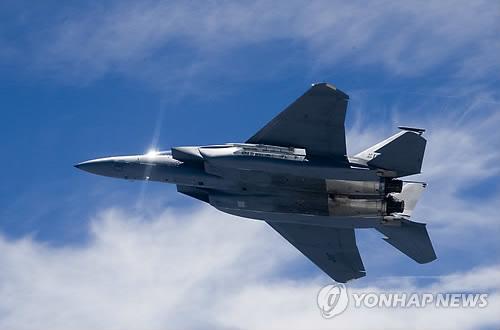News Focus) 'Stealthy' F-15 SE leaves questions over future warfare capabilities
By Kim Eun-jung
2013/08/22 13:39
SEOUL, Aug. 22 (Yonhap) -- Boeing's F-15 Silent Eagle (SE) is the only remaining candidate for South Korea's next-generation fighter jet project, but questions persist over whether it can meet operational needs to counter potential threats from North Korea and other Asian neighbors flexing their military muscles, experts say.
Boeing's F-15 SE vied with Lockheed Martin's F-35 and EADS' Eurofighter for the 8.3 trillion won (US$7.2 billion) deal to sell 60 aircraft, but only Boeing's bid fell within Seoul's budget, the key precondition to win the contract.
After conducting evaluations on the jets, a final decision on whether to accept or reject the sole candidate will be made in a meeting of top military officials slated for mid-September.
If confirmed, Boeing will provide the "stealthy" variant of the F-15 SE between 2017 and 2021 to operate alongside 60 F-15Ks, which have been adopted since 2002, effectively replacing the South Korean Air Force's aging fleet of F-4s and F-5s. But experts question whether it is the best option.

Improvements on the F-15 SE include a conformal weapons bay (CWB), fly-by-wire flight controls and other enhance avionics, including an integrated Active Electronically Scanned Array (AESA) radar.
"The Silent Eagle is a low-risk, affordable solution based on the combat-proven F-15 family of fighter jets," the company said in a statement. "Using a modular-design approach, the Silent Eagle offers unique aerodynamic, avionics and radar cross-section (RCS) reduction features that provide the user with maximum flexibility."
Boeing says the conformal weapons bay can enhance radar-evading capabilities in th early days of a battle. Once air superiority is assured, they can be replaced with conformal fuel tanks, converting the plane to an external weapons load configuration for better speed and payload capacity.
Although Boeing had pitched canted tail fins as one of the key stealth-enhancing features, its final proposal dropped the design to meet Seoul's tight budget and delivery schedule.
Lee Hee-woo, head of a military research institute at Chungnam National University, said the combat aircraft customized for the South Korean Air Force would need a comparatively higher operational cost due to economies of scale. "The F-15 SE is not designed as a stealth jet from the beginning," Lee said. "Its survivability has been improved, but the model built for the South Korean Air Force will need higher operational cost."
In terms of deterring provocations, experts say operating radar-evading jets can deliver a message to Pyongyang, which threatened nuclear war against Seoul and Washington in response to their annual military drills earlier this year.
The U.S. Air Force sent B-2 stealth bombers and F-22 stealth jets to the Korean Peninsula as part of the joint exercise in a show of force after the North threatened to strike South Korea and the U.S. military bases in Hawaii and Guam.
"North Korea sensitively responded to U.S. deployment of B-2 bombers earlier this year. We should prepare defense policies to acquire strategic weapons systems," said a retired four-star Air Force general.
Military analysts stress the need to acquire strategic weapons as the Korean Peninsula is encircled by China and Japan, which are at odds with each other over territorial disputes and seek to expand military power.
The hawkish Japanese Prime Minister Shinzo Abe took office in December for a rare second term, pledging to bolster the military to cope with what Japan sees as an increasingly threatening security environment including an assertive China and an unpredictable North Korea.
Last year, Tokyo signed a deal to buy 42 F-35s by Lockheed Martin, with the first four planes scheduled for delivery in 2017.
China's military capabilities lag far behind those of the U.S., but China is aggressively seeking to boost its strength by developing its own stealth jets and launching its first aircraft carrier last year.
When China flew its first stealth aircraft, the J-20, in 2011, it sounded its neighbors' alarm bells as the well-funded Chinese military's efforts seemed to bear fruit. The J-20 is still in the development phase, and it is expected to be operational starting between 2017-2019, according to Chinese media.
Shin In-kyun, a military expert who runs the Korea Defense Network, said South Korea should have high-low mix aircraft to defend its air space during future operations to replace its aging jets and deter future threats.
"To counter North Korean combat aircraft and destroy artillery bases, FA-50 light attack jets are enough," Shin said. "The next-generation fighter jet should be able to handle the potential future risks."
Source: english.yonhapnews.co.kr
oldmarine
'Yonhap' 카테고리의 다른 글
| 美 "北, 미사일 자랑보다 주민 먹여살려야"(종합) (0) | 2013.10.10 |
|---|---|
| (News Focus) S. Korean fighter competition fizzles out due to tight, inflexible budget (0) | 2013.09.29 |
| 문재인 "김정일에 건넨 문건, 경협 문건 3건"(종합) (0) | 2013.09.18 |
| (News Focus) S. Korea-U.S. summit to push N. Korea to review policy options (0) | 2013.09.09 |
| <日 한국엔 `전방위 보복'..중국엔 '유연 대응'> (0) | 2013.08.17 |